The 100th anniversary of Children’s Book Week is being celebrated April 29–May 5 at bookstores, libraries, and schools across the country. This year’s theme, Read Now, Read Forever, “looks to the past, present, and most important, the future of children’s books.” In reflecting on the importance of free choice in our own development as lifelong readers, this week we review books that we were especially eager to read.
Ages 4–8
Circle. Mac Barnett. Ill. Jon Klassen. 2019. Candlewick.
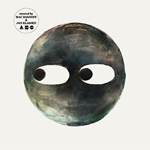 In the conclusion of this shapes trilogy, Circle invites Square and Triangle to play hide-and-seek anywhere except behind the waterfall where it is dark, which is exactly where Circle has to rescue frightened Triangle and where they both are scared by a pair of eyes. Jon Klassen’s minimalistic illustrations (created digitally and with watercolor and graphite) morph from outdoor scenes against expansive white backgrounds into black double-page spreads featuring only eyes. Back safely from behind the waterfall, Circle talks about what they saw deep in the cave and muses, “It might have been a good shape. We just could not see it.” Circle instructs her friends to close their eyes and imagine what kind of shape it was. On the final black page, the question “If you close your eyes, what shape do you picture?” invites readers to do the same.
In the conclusion of this shapes trilogy, Circle invites Square and Triangle to play hide-and-seek anywhere except behind the waterfall where it is dark, which is exactly where Circle has to rescue frightened Triangle and where they both are scared by a pair of eyes. Jon Klassen’s minimalistic illustrations (created digitally and with watercolor and graphite) morph from outdoor scenes against expansive white backgrounds into black double-page spreads featuring only eyes. Back safely from behind the waterfall, Circle talks about what they saw deep in the cave and muses, “It might have been a good shape. We just could not see it.” Circle instructs her friends to close their eyes and imagine what kind of shape it was. On the final black page, the question “If you close your eyes, what shape do you picture?” invites readers to do the same.
—NB
The Donkey Egg. Janet Stevens & Susan Stevens Crummel. Ill. Janet Stevens. 2019. Houghton Mifflin.
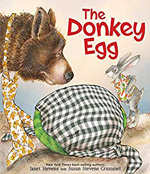 Bear sleeps in his chair instead of taking care of his farm until Fox tricks him into buying a big, green donkey egg for 20 dollars, and his life changes. He cares for his “egg” by sitting on it, singing to it, telling it stories (and acting out parts), dancing and playing with it, and rocking it—until he drops it when he falls asleep. With the egg “on the loose!” Bear and friends chase after it until the green donkey egg cracks open. Disappointed, Bear and good friend Hare plant the seeds found inside and grow watermelons they sell to buy a donkey! Expressive, mixed-media illustrations, inserts with fun facts, and playful text provide a laugh-out-loud trickster tale.
Bear sleeps in his chair instead of taking care of his farm until Fox tricks him into buying a big, green donkey egg for 20 dollars, and his life changes. He cares for his “egg” by sitting on it, singing to it, telling it stories (and acting out parts), dancing and playing with it, and rocking it—until he drops it when he falls asleep. With the egg “on the loose!” Bear and friends chase after it until the green donkey egg cracks open. Disappointed, Bear and good friend Hare plant the seeds found inside and grow watermelons they sell to buy a donkey! Expressive, mixed-media illustrations, inserts with fun facts, and playful text provide a laugh-out-loud trickster tale.
—NB
Good Boy. Sergio Ruzzier. 2019. Atheneum/Simon & Schuster.
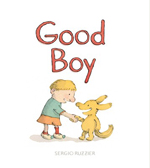 With only one or two words on a page, Sergio Ruzzier tells a delightful story of a small boy and his dog that begins with the boy training the dog with simple commands (sit, stay, roll over) and then moves on to tricks (stand, shake, bow) and playful activities (fetch, jump, juggle). After the clever dog cooks and serves a meal, they eat, clean up, and head outdoors. Colorful illustrations (rendered in ink and watercolor) show the pair heading to the beach in a pedal-powered cart, fixing a damaged boat, sailing to an island, building a rocket, and soaring to a planet where they make new friends before returning home. Young children will become aware of an apparent shift in their relationship during their bedtime routine (wash, brush, dress, read, sing) that ends with “Stay. Good boy.”
With only one or two words on a page, Sergio Ruzzier tells a delightful story of a small boy and his dog that begins with the boy training the dog with simple commands (sit, stay, roll over) and then moves on to tricks (stand, shake, bow) and playful activities (fetch, jump, juggle). After the clever dog cooks and serves a meal, they eat, clean up, and head outdoors. Colorful illustrations (rendered in ink and watercolor) show the pair heading to the beach in a pedal-powered cart, fixing a damaged boat, sailing to an island, building a rocket, and soaring to a planet where they make new friends before returning home. Young children will become aware of an apparent shift in their relationship during their bedtime routine (wash, brush, dress, read, sing) that ends with “Stay. Good boy.”
—CA
Motor Mouse (Motor Mouse #1). Cynthia Rylant. Ill. Arthur Howard. 2019. Beach Lane/Simon & Schuster.
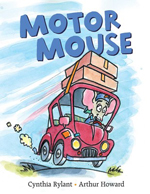 Cynthia Rylant and Arthur Howard introduce Motor Mouse, who delivers packages all around town in his little red motorcar, in three short stories with colorful, boldly outlined cartoons. In the first story, when their end-of-week celebration is ruined by the closing of the Cake Shop, a friendly hedgehog takes Motor Mouse and Telly (his otter pal) to eat pie on Cake Friday. “And it was QUITE ACCEPTABLE.” In the second, on his day off, Motor Mouse hires a cab so he can look around town without having to keep his eye on the road and ends up sharing memories and making friends with the cabbie (a raccoon). In the final story, on Saturday at the movies, Motor Mouse has the perfect solution to a weekly dispute with his brother, Valentino, over sharing popcorn: a “biggest bucket” for each of them.
Cynthia Rylant and Arthur Howard introduce Motor Mouse, who delivers packages all around town in his little red motorcar, in three short stories with colorful, boldly outlined cartoons. In the first story, when their end-of-week celebration is ruined by the closing of the Cake Shop, a friendly hedgehog takes Motor Mouse and Telly (his otter pal) to eat pie on Cake Friday. “And it was QUITE ACCEPTABLE.” In the second, on his day off, Motor Mouse hires a cab so he can look around town without having to keep his eye on the road and ends up sharing memories and making friends with the cabbie (a raccoon). In the final story, on Saturday at the movies, Motor Mouse has the perfect solution to a weekly dispute with his brother, Valentino, over sharing popcorn: a “biggest bucket” for each of them.
—CA
Ruby & Rufus Love the Water! (Gossie & Friends). Olivier Dunrea. 2019. Houghton Mifflin.
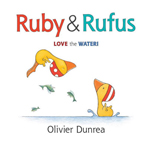 In this twelfth book in his series begun with Gossie (2002), Olivier Dunrea introduces two new goslings: Ruby in a red bathing cap with white polka dots and Rufus in a red-and-white striped cap. They swim on the pond all day and every day, until one cold snowy morning, they find the water is frozen. Still in their bathing caps, they slide across the ice and streak across the ice in their red-and-white inner tube throughout the winter until warm weather returns and they play once again in the water. “Ruby and Rufus love the pond all year round.” The spare text and charming ink-and-watercolor illustrations featuring the two small friends at play and set against expansive white backgrounds make this small book perfect for sharing again and again with young children.
In this twelfth book in his series begun with Gossie (2002), Olivier Dunrea introduces two new goslings: Ruby in a red bathing cap with white polka dots and Rufus in a red-and-white striped cap. They swim on the pond all day and every day, until one cold snowy morning, they find the water is frozen. Still in their bathing caps, they slide across the ice and streak across the ice in their red-and-white inner tube throughout the winter until warm weather returns and they play once again in the water. “Ruby and Rufus love the pond all year round.” The spare text and charming ink-and-watercolor illustrations featuring the two small friends at play and set against expansive white backgrounds make this small book perfect for sharing again and again with young children.
—CA
Ages 9–11
The Parrot and the Merchant: A Tale by Rumi. Marjan Vafaeian. Trans. Azita Rassi. 2019. Tiny Owl.
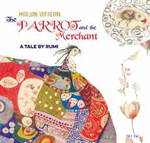 Mah Jahan, a traveling Persian merchant, collects beautiful birds that she keeps in cages or in chains. When Mah Jahan asks her favorite bird, a talking parrot, what gift she could bring her when she returns from a trading trip, the sad bird requests that she say hello to her parrot friends who live wild and free in the Indian jungle and ask if they have any messages for her. Upon returning home, Mah Jahan reports, “I’m afraid that they said nothing at all, but one poor parrot fell out of the tree, dead.” The parrot’s response to this message teaches Mah Jahan a surprising but important lesson about freedom, happiness, and love. Iranian illustrator Marjan Vafaeian’s choice to make the merchant a woman provides the opportunity to dress Mah Jahan in voluminous, exquisitely patterned gowns in the stylized illustrations for this ancient fable.
Mah Jahan, a traveling Persian merchant, collects beautiful birds that she keeps in cages or in chains. When Mah Jahan asks her favorite bird, a talking parrot, what gift she could bring her when she returns from a trading trip, the sad bird requests that she say hello to her parrot friends who live wild and free in the Indian jungle and ask if they have any messages for her. Upon returning home, Mah Jahan reports, “I’m afraid that they said nothing at all, but one poor parrot fell out of the tree, dead.” The parrot’s response to this message teaches Mah Jahan a surprising but important lesson about freedom, happiness, and love. Iranian illustrator Marjan Vafaeian’s choice to make the merchant a woman provides the opportunity to dress Mah Jahan in voluminous, exquisitely patterned gowns in the stylized illustrations for this ancient fable.
—CA
Trees: A Rooted History. Piotr Sacha. Trans. Anna Burgess. Ill. Wojciech Grajkowski. 2019. Abrams.
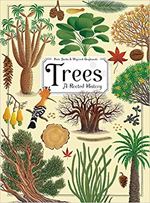 This oversize compendium on trees includes spreads of colorful, intricate drawings with explanatory text on the vertical margins covering the characteristics and diversity of trees, their place in the natural world, and roles they have played from ancient times to the present in the lives of humans. Browsers will be attracted to topics such as endemic species, the oldest trees, treehouses from around the world, and tree monsters in mythology, folklore, and literature. The final entry, “Trees for the Future,” picturing a giant sequoia being chopped down by lumberjacks, is a reminder of the importance of planting trees and thinking twice before we cut them down.
This oversize compendium on trees includes spreads of colorful, intricate drawings with explanatory text on the vertical margins covering the characteristics and diversity of trees, their place in the natural world, and roles they have played from ancient times to the present in the lives of humans. Browsers will be attracted to topics such as endemic species, the oldest trees, treehouses from around the world, and tree monsters in mythology, folklore, and literature. The final entry, “Trees for the Future,” picturing a giant sequoia being chopped down by lumberjacks, is a reminder of the importance of planting trees and thinking twice before we cut them down.
—CA
Ages 12–14
The Giver (Giver Quartet #1). Lois Lowry. Adapt. P. Craig Russell. Ill. P. Craig Russell, Galen Showman, & Scott Hampton. 2019. Houghton Mifflin.
 P. Craig Russell’s graphic novel adaptation of Lois Lowry’s The Giver closely follows the dialogue of the original story, and the paneled artwork (rendered in blue pencil, pencil, ink, blue ink wash, and grey ink wash) provides a dramatic visual representation of events as they unfold. After he is selected by the Committee of Elders to be the next Receiver of Memory, 12-year-old Jonas begins to question the colorless, conforming, and controlling Sameness of the community in which he lives as the Giver begins to transfer all the memories of the whole world to him—and he learns disturbing secrets about this seemingly utopian society. Conversations with Lowry and Russell about the graphic adaptation of this provocative 1994 Newbery Medal-winning fantasy are appended.
P. Craig Russell’s graphic novel adaptation of Lois Lowry’s The Giver closely follows the dialogue of the original story, and the paneled artwork (rendered in blue pencil, pencil, ink, blue ink wash, and grey ink wash) provides a dramatic visual representation of events as they unfold. After he is selected by the Committee of Elders to be the next Receiver of Memory, 12-year-old Jonas begins to question the colorless, conforming, and controlling Sameness of the community in which he lives as the Giver begins to transfer all the memories of the whole world to him—and he learns disturbing secrets about this seemingly utopian society. Conversations with Lowry and Russell about the graphic adaptation of this provocative 1994 Newbery Medal-winning fantasy are appended.
—CA
The Weight of Our Sky. Hanna Alkaf. 2019. Salaam Reads/Simon & Schuster.
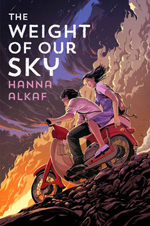 It’s 1969 in Kuala Lumpur, Malaysia, and 16-year-old Melati Ahmad, a Muslim Malay, struggles with OCD, which arose after the death of her father the prior year. Counting and tapping objects while performing daily rituals (compulsive phone calls, blinking, flicking light switches) is exhausting, and her thoughts are often hijacked by an inner djinn predicting her mother’s horrific death unless she follows his specific instructions. On May 13, Melati is rescued by a stranger, Chinese Auntie Bee, from a movie theater where her best friend, Safiyah, is killed by terrorists, and she finds herself in the middle of a violent race riot between Malays and Chinese. To survive, Mel must fight against her inner demon and crippling compulsions and let strangers into her life while she searches for her mother and promotes unity. “We make our own sky, and we can hold it up—together.”
It’s 1969 in Kuala Lumpur, Malaysia, and 16-year-old Melati Ahmad, a Muslim Malay, struggles with OCD, which arose after the death of her father the prior year. Counting and tapping objects while performing daily rituals (compulsive phone calls, blinking, flicking light switches) is exhausting, and her thoughts are often hijacked by an inner djinn predicting her mother’s horrific death unless she follows his specific instructions. On May 13, Melati is rescued by a stranger, Chinese Auntie Bee, from a movie theater where her best friend, Safiyah, is killed by terrorists, and she finds herself in the middle of a violent race riot between Malays and Chinese. To survive, Mel must fight against her inner demon and crippling compulsions and let strangers into her life while she searches for her mother and promotes unity. “We make our own sky, and we can hold it up—together.”
—NB
Ages 15+
The Gilded Wolves (Gilded Wolves #1). Roshani Chokshi. 2019. Wednesday/St. Martin/Macmillan.
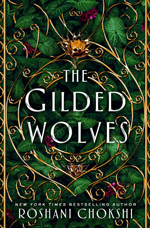 In this complex fantasy set in 1889 Paris, the Exposition Universelle (world’s fair) is about to open. Séverin Montagnet-Alarie (illegitimate French-Algerian disowned heir of the disbanded House Vanth) is enlisted by former childhood companion Hypnos (French-Haitian and Patriarch of the House Kore) to bring him the Eye of Horus in exchange for restoring Séverin’s inheritance. Séverin, assisted by an international team of experts, each with secrets, solves riddles and puzzles to uncover the artifact before it can be used by revolutionaries to transform themselves into gods. Chokshi threads postcolonial themes into this steampunk-esque thrilling opener to this new series told through the points of view of a cast of memorable characters.
In this complex fantasy set in 1889 Paris, the Exposition Universelle (world’s fair) is about to open. Séverin Montagnet-Alarie (illegitimate French-Algerian disowned heir of the disbanded House Vanth) is enlisted by former childhood companion Hypnos (French-Haitian and Patriarch of the House Kore) to bring him the Eye of Horus in exchange for restoring Séverin’s inheritance. Séverin, assisted by an international team of experts, each with secrets, solves riddles and puzzles to uncover the artifact before it can be used by revolutionaries to transform themselves into gods. Chokshi threads postcolonial themes into this steampunk-esque thrilling opener to this new series told through the points of view of a cast of memorable characters.
—NB
The Last Voyage of Poe Blythe. Ally Condie. 2019. Dutton/Penguin.
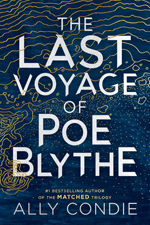 After engineer Poe Blythe loses Call, her childhood love whom she met in an orphanage, in a raid on the ship they’re working on, she vows revenge on the raiders who killed him. The Admiral (protector of the settlers in the abandoned Outpost)names Poe, now 17, Captain of the Gilded Lily, for which she’s designed the most failsafe raider-proof ship armor ever created so its crew can safely trench gold from the river. Beginning with her first day on the ship, she receives threatening messages from someone on her crew. Betrayal, sabotage, and challenges cause her to question who the raiders are, why the Admiral needs so much gold, and if her loyalties are being wrongly manipulated—and result in her ripping apart her beloved ship to fight the almost-inevitable course of events in this action-filled dystopian novel.
After engineer Poe Blythe loses Call, her childhood love whom she met in an orphanage, in a raid on the ship they’re working on, she vows revenge on the raiders who killed him. The Admiral (protector of the settlers in the abandoned Outpost)names Poe, now 17, Captain of the Gilded Lily, for which she’s designed the most failsafe raider-proof ship armor ever created so its crew can safely trench gold from the river. Beginning with her first day on the ship, she receives threatening messages from someone on her crew. Betrayal, sabotage, and challenges cause her to question who the raiders are, why the Admiral needs so much gold, and if her loyalties are being wrongly manipulated—and result in her ripping apart her beloved ship to fight the almost-inevitable course of events in this action-filled dystopian novel.
—NB
Nancy Brashear is Professor Emeritus of English, Azusa Pacific University, in Azusa, California. Carolyn Angus is former director of the George G. Stone Center for Children's Books, Claremont Graduate University, in Claremont, California.
These reviews are submitted by members of the International Literacy Association's Children's Literature and Reading Special Interest Group (CL/R SIG) and are published weekly on Literacy Daily.